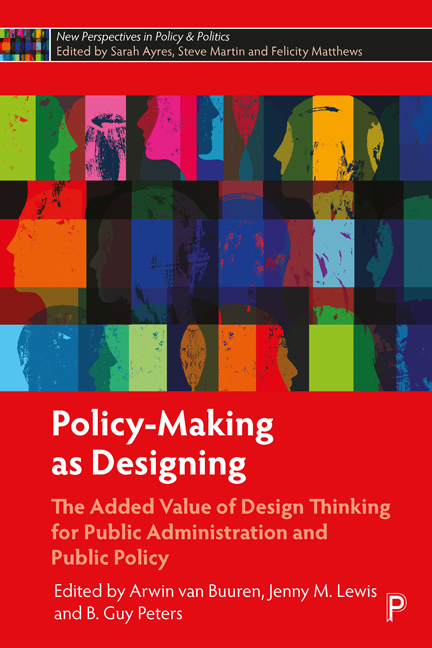 Policy-Making as Designing
Policy-Making as Designing Book contents
- Frontmatter
- Contents
- List of figures and tables
- Notes on contributors
- 1 Improving public policy and administration: exploring the potential of design
- 2 Applying design in public administration: a literature review to explore the state of the art
- 3 Challenges in applying design thinking to public policy: dealing with the varieties of policy formulation and their vicissitudes
- 4 Designing environments for experimentation, learning and innovation in public policy and governance
- 5 Policy Labs: the next frontier of policy design and evaluation?
- 6 When design meets power: design thinking, public sector innovation and the politics of policy-making
- 7 Designing institutions for designing policy
- 8 Applying design science in public policy and administration research
- 9 Using a design approach to create collaborative governance
- 10 Policy-making as designing: taking stock and looking forward
- Index
9 - Using a design approach to create collaborative governance
Published online by Cambridge University Press: 20 January 2024
- Frontmatter
- Contents
- List of figures and tables
- Notes on contributors
- 1 Improving public policy and administration: exploring the potential of design
- 2 Applying design in public administration: a literature review to explore the state of the art
- 3 Challenges in applying design thinking to public policy: dealing with the varieties of policy formulation and their vicissitudes
- 4 Designing environments for experimentation, learning and innovation in public policy and governance
- 5 Policy Labs: the next frontier of policy design and evaluation?
- 6 When design meets power: design thinking, public sector innovation and the politics of policy-making
- 7 Designing institutions for designing policy
- 8 Applying design science in public policy and administration research
- 9 Using a design approach to create collaborative governance
- 10 Policy-making as designing: taking stock and looking forward
- Index
Summary
Introduction
In complex, shared-power settings, policy-makers, administrators and many other decision makers increasingly must engage in collaborative governance in order to effectively address challenging public issues that cannot be handled by single public organisations alone, or even by single sectors (Gray and Purdy, 2018; Innes and Booher, 2018). These collaborations must be governed effectively if their public purposes are to be achieved. This chapter makes three contributions toward improving the governance of collaborations: first, we argue that a design approach to the governance of collaborations offers several benefits – both for designing a process for developing and guiding collaborations and for creating specific governance designs. Second, we enrich the theoretical and practical understanding of the nature and elements of collaborative governance by drawing on Crosby and Bryson's (2005) ‘triple three-dimensional view of power’ to argue that the design and use of forums for dialogue and deliberation, arenas for decision making and courts for resolving residual disputes and reinforcing underlying norms are crucial to creating effective collaboration processes and governance regimes. And third, we illustrate our argument by examining the emergence of a collaboration designed to cope with the fragmented field of minority business support in order to foster greater racial equity in income and wealth. Collaboration in this case means the linking or sharing of information, resources, activities and capabilities by organisations to achieve jointly an outcome they could not achieve alone (Huxham and Vangen, 2005).
Definitions of collaborative governance vary (Gash, 2016). We adapt Emerson and Nabatchi's argument (2015: 18) to say it encompasses ‘the processes and structures of public policy – and policy-related [added] – decision making and management that engage people across the boundaries of public agencies, levels of government and/or the public, private, and civic spheres to carry out a public purpose that could not otherwise be accomplished’.
Our argument proceeds in several sections. First, we review what a design approach might add to collaborative governance literature. Second, we reprise Crosby and Bryson's (2005) ‘triple three-dimensional view of power’ and their forums, arenas and courts framework and adapt it to the challenge of designing and realising effective collaborative governance.
- Type
- Chapter
- Information
- Policy-Making as DesigningThe Added Value of Design Thinking for Public Administration and Public Policy, pp. 191 - 217Publisher: Bristol University PressPrint publication year: 2023


